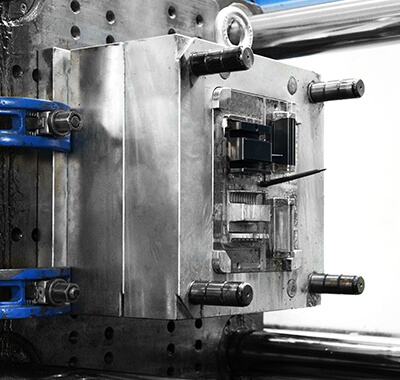Introduction:
Injection molding is a manufacturing process that involves producing complex plastic parts by injecting molten plastic into a mold cavity. The mold is the heart of the injection molding process, and the design of the mold is critical to the success of the process. The mold’s design directly affects the quality of the final product, the manufacturing process’s efficiency, and the production cost.

Basic Mold Design:
Before discussing the importance of designing injection molds for high-quality production, it is essential to understand the basics of mold design. A mold consists of two halves, a core and a cavity. The body is the internal part of the mold, and the hole is the outer part. When the two halves are clamped together, they form a mold cavity, which is the shape of the final product.
The design of the mold depends on the complexity of the final product. Simple products can be produced with a basic mold design, while complex products require a more complex one. The mold design also depends on the manufacturing process, the material used, and the production volume.
Injection Mold Design:
The design of the injection mold is critical to the success of the injection molding process. The injection mold design involves several factors: part design, material selection, mold design, and production volume.
Part Design:
The part design is the first step in the injection mold design process. The part design defines the shape and size of the final product. The part design also determines the number of cavities required in the mold. The number of holes affects the production volume and the cost of production.
Material Selection:
Material selection is another critical factor in the injection mold design process. The final product’s material determines the injection molding process’s temperature and pressure requirements. The material selection also affects the mold design and the production volume.
Mold Design:
The mold design is the most critical factor in the injection mold design process. The mold design includes several elements, such as the gate location, runner system, cooling system, and ejection system.
The gate location is where molten plastic enters the mold cavity. The gate location affects the plastic flow in the mold cavity, affecting the final product’s quality.
The runner system is the channel network connecting the gate to the mold cavity. The runner system determines the plastic flow in the mold cavity, which affects the final product’s quality.
The cooling system removes the heat from the molten plastic, allowing it to solidify and form the final product. The cooling system affects the cycle time of the injection molding process, which involves the production volume.
The ejection system removes the final product from the mold cavity. The ejection system affects the quality of the final product, as any damage to the product during ejection can result in a defective product.
Production Volume:
The production volume is another critical factor in the injection mold design process. The production volume determines the mold design, as high-volume production requires a more durable one. The production volume also affects the cost of production, as high-volume production requires a more expensive mold design.
Plastic Injection Mold Design:
The design of the plastic injection mold is critical to the success of the injection molding process. The plastic injection mold design involves several factors: part design, material selection, mold design, and production volume.
Part Design:
Part design is the first step in the plastic injection mold design process. The part design defines the shape and size of the final product. The part design also determines the number of cavities required in the mold. The number of holes affects the production volume and the cost of production.
Material Selection:
Material selection is another critical factor in the plastic injection mold design process. The final product’s material determines the injection molding process’s temperature and pressure requirements. The material selection also affects the mold design and the production volume.
Mold Design:
The mold design is the most critical factor in plastic injection mold design. The mold design includes several elements, such as the gate location, runner system, cooling system, and ejection system.
The gate location is where molten plastic enters the mold cavity. The gate location affects the plastic flow in the mold cavity, affecting the final product’s quality.
The runner system is the channel network connecting the gate to the mold cavity. The runner system determines the plastic flow in the mold cavity, which affects the final product’s quality.
The cooling system removes the heat from the molten plastic, allowing it to solidify and form the final product. The cooling system affects the cycle time of the injection molding process, which involves the production volume.
The ejection system removes the final product from the mold cavity. The ejection system affects the quality of the final product, as any damage to the product during ejection can result in a defective product.
Production Volume:
Production volume is another critical factor in plastic injection mold design. The production volume determines the mold design, as high-volume production requires a more durable one. The production volume also affects the cost of production, as high-volume production requires a more expensive mold design.
Rapid Prototype Injection Molds:
Rapid prototype injection molds are used to produce small quantities of plastic parts. Fast prototype injection molds are designed to be cost-effective and quick to make. The design of rapid prototype injection molds is different from that of high-volume production molds.
The design of rapid prototype injection molds focuses on speed and cost. The mold design is simplified to reduce the cost of production. The number of cavities is also reduced to minimize the cycle time of the injection molding process.
The material used in rapid prototype injection molds differs from that used in high-volume production molds. The material used in fast prototype injection molds is typically less durable, allowing for a lower cost of production.
The Importance of Designing Injection Molds for High-Quality Production:
The importance of designing injection molds for a high-quality product cannot be overstated. The design of the injection mold directly affects the quality of the final product, the manufacturing process’s efficiency, and the production cost.
The quality of the final product is directly affected by the mold design. The mold design affects the plastic flow in the cavity, affecting the final product’s quality. The mold design also affects the plastic’s cooling time, affecting the final product’s quality.
The efficiency of the manufacturing process is also directly affected by mold design. The mold design affects the cycle time of the injection molding process, which involves the production volume. A more efficient mold design allows for higher production volumes, reducing the cost of production.
The cost of production is also directly affected by mold design. The mold design affects the cost of production, as high-volume production requires a more expensive mold design. A more efficient mold design allows for higher production volumes, reducing the cost of production.
Conclusion:
The importance of designing injection molds for high-quality products must be considered. The design of the injection mold directly affects the quality of the final product, the manufacturing process’s efficiency, and the production cost. The mold design includes several elements, such as the gate location, runner system, cooling system, and ejection system. The production volume is also a critical factor in the mold design process. Material selection is another essential factor for the plastic injection mold design process. Different materials require different temperatures and pressures during the injection molding process, which affects the mold design and the production volume.
Rapid prototype injection molds are a cost-effective option for producing small plastic parts. The design of fast prototype injection molds differs from that of high-volume production molds, focusing on speed and cost. The material used in quick prototype injection molds is typically less durable than in high-volume production molds.
Designing high-quality injection molds is essential for achieving high-quality plastic parts. The mold design affects the quality of the final product, the manufacturing process’s efficiency, and the production cost. Factors such as material selection and production volume also play a significant role in mold design. By considering these factors, manufacturers can design injection molds that meet their specific needs and achieve the desired results.
